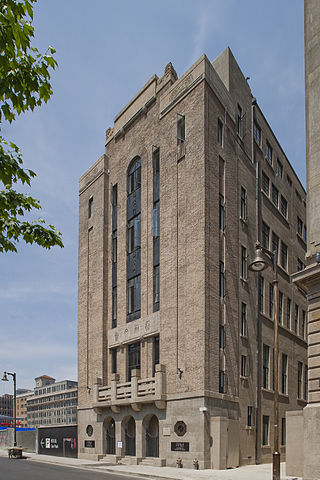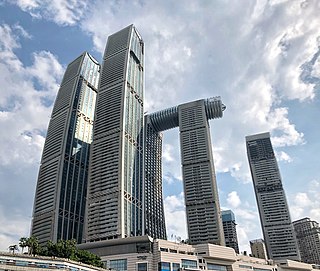
1933 (or "Old Millfun") is a complex of restaurants and shops in Hongkou District of Shanghai, China. The poured-concrete structures once housed the Shanghai Municipal Council Slaughterhouse, the largest slaughterhouse in Shanghai at the time. [1]

1933 (or "Old Millfun") is a complex of restaurants and shops in Hongkou District of Shanghai, China. The poured-concrete structures once housed the Shanghai Municipal Council Slaughterhouse, the largest slaughterhouse in Shanghai at the time. [1]
The five buildings were built in 1933 during the Republic of China period. [2] Property managers say that they comprise 32,500 square meters, [3] described by the Atlas Obscura travel guide as "an eerie Gotham-Deco achievement in concrete, glass, and steel, and the last remaining of its design in the world." [2] Curved staircases, bridged walkways, and thick walls give the complex a unique industrial aura, especially for an area aspiring to house cuisine and the arts. [4]
The buildings were under renovation in 1998 after years of abandonment. The building became old and decayed and occupied by squatters. [2]

The Jin Mao Tower, also known as the Jinmao Building or Jinmao Tower, is a 420.5-meter-tall (1,380 ft), 88-story landmark skyscraper in Lujiazui, Pudong, Shanghai, China. It contains a shopping mall, offices and the Grand Hyatt Shanghai hotel which starts from the 53rd floor, which at the time of completion was the highest hotel in the world. Along with the Oriental Pearl Tower, the Shanghai World Financial Center and the Shanghai Tower it is part of the Lujiazui skyline seen from the Bund. It was the tallest building in China from its completion in 1999 until 2007, when it was surpassed by the Shanghai World Financial Center which is located close by. The Shanghai Tower, a 128-story building located next to these two buildings, surpassed the height of both these buildings in 2015, creating the world's first trio of adjacent supertall skyscrapers.

The Bund is a waterfront area and a protected historical district in central Shanghai. The area centers on a section of Zhongshan Road within the former Shanghai International Settlement, which runs along the western bank of the Huangpu River in the eastern part of Huangpu. The area along the river faces the modern skyscrapers of Lujiazui in Pudong. The Bund usually refers to the buildings and wharves on this section of the road, as well as some adjacent areas. This region has a significant European influence, with the style of many structures most comparable to that of European cities, particularly Gothic, Baroque, Neoclassical, Romanesque, Art Deco, and Renaissance architecture. Additionally, some of the city's top eateries are located there. From the 1860s to the 1930s, it was the rich and powerful center of the foreign establishment in Shanghai, operating as a legally protected treaty port.

Hongkou is a district of Shanghai, forming part of the northern urban core. It has a land area of 23.48 km2 (9.07 sq mi) and a population of 757,498 as of 2020. The district borders Yangpu to the east, Pudong to the southeast, Huangpu to the southwest, Jing'an to the west and Baoshan to the north.

Zhabei, formerly romanized as Chapei, is a neighborhood and a former district of Shanghai with a land area of 29.26 km2 (11.30 sq mi) and a resident population of 847,300 as of 2013. It is the location of the Shanghai railway station, one of the main railway stations of Shanghai. On November 4, 2015, Zhabei was merged into the smaller but more central Jing'an District.

The Queen Elizabeth Hall (QEH) is a music venue on the South Bank in London, England, that hosts classical, jazz, and avant-garde music, talks and dance performances. It was opened in 1967, with a concert conducted by Benjamin Britten.

The Peace Hotel is a hotel on The Bund in Shanghai, China, which overlooks the surrounding areas. The hotel has two different buildings. The Sassoon House, originally housed the Cathay Hotel and is today the Fairmont Peace Hotel run by Fairmont Hotels and Resorts of Canada. The South Building was built as the Palace Hotel and is today a residence and studio for artists, known as The Swatch Art Peace Hotel. The two buildings both face the Bund, but are divided by Nanjing Road.

Park Hotel, historically the Shanghai Joint Savings Society Building, is an Art Deco hotel on Nanjing West Road, Shanghai, China. It was the tallest building in Asia from its completion in 1934 to 1963.

Shanghai Club Building (上海总会大楼) is a six-storey Baroque Revival building at The Bund, Huangpu, Shanghai, China. It was originally constructed in 1864 and opened in 1911, and was designated as a major cultural heritage site under national-level protection. Currently, it is operated by the Waldorf Astoria Shanghai on the Bund.

Lu Xun Park, formerly Hongkou (Hongkew) Park, is a municipal park in Hongkou District of Shanghai, China. It is located on 146 East Jiangwan Road, right behind Hongkou Football Stadium. It is bounded by Guangzhong Road to the north, Ouyang Road to the northeast, Tian'ai Road to the southeast, Tian'ai Branch Road to the south, and East Jiangwan Road to the west. The park is named after the Chinese writer Lu Xun, who lived nearby in the last years of his life, and is the location of the tomb of Lu Xun and the Lu Xun Museum. In 1932, Korean nationalist Yun Bong-gil detonated a bomb at the park, killing or injuring several high-ranking figures of the Imperial Japanese military during a celebration of Emperor Hirohito's birthday.

Hailun Road is an interchange station between Lines 4 and 10 of the Shanghai Metro, and is located in the city's Hongkou District. Service began on Line 4 on 31 December 2005, while the interchange with Line 10 opened on 10 April 2010 as part of that line's initial section between Xinjiangwancheng and Hangzhong Road. Towards anti-clockwise on Line 4, this is the last station before sharing with Line 3.
Shanghai Tower is a 128-story, 632-meter-tall (2,073 ft) megatall skyscraper located in Lujiazui, Pudong, Shanghai. It is the tallest building in China and the world's third-tallest building by height to architectural top. It is the tallest and largest LEED Platinum certified building in the world since 2015. It had the world's fastest elevators at a top speed of 20.5 meters per second until 2017, when it was surpassed by the Guangzhou CTF Finance Center, with its top speed of 21 meters per second. Designed by the international design firm Gensler and owned by the Shanghai Municipal Government, it is the tallest of the world's first triple-adjacent supertall buildings in Pudong, the other two being the Jin Mao Tower and the Shanghai World Financial Center. Its tiered construction, designed for high energy efficiency, provides nine separate zones divided between office, retail and leisure use. The US-based Council on Tall Buildings and Urban Habitat cites it as "one of the most sustainably advanced tall buildings in the world."

The Ping An Finance Center is a 115-storey, 599.1 m (1,966 ft) supertall skyscraper in Shenzhen, Guangdong, China. The building was commissioned by Ping An Insurance and designed by the American architectural firm Kohn Pedersen Fox Associates. It was completed in 2017, and is the tallest building in Shenzhen, the 2nd tallest building in China and the 5th tallest building in the world. It also broke the record of having the highest observation deck in a building at 562 m (1,844 ft). It is the second largest skyscraper in the world by floor area after Azabudai Hills Main Tower in Tokyo, Japan.

Shanghai Rush is a Chinese reality television program broadcast by International Channel Shanghai as part of the TV scheduling leading up to the 2010 Shanghai Expo and designed to showcase the city. The series borrowed heavily from the themes of the American reality show The Amazing Race and was produced by Fly Films. The show aired in early 2009, and ended broadcast in July of the same year. Shanghai Rush focused on travel throughout the municipality of Shanghai. After finishing Shanghai Rush, International Channel Shanghai acquired the rights to produce a show under the Amazing Race brand, resulting in the 2010 broadcast of The Amazing Race: China Rush. The winning team of Shanghai Rush was Richard Lin and Alice Tsui Lin.

St Peter's Church is a Catholic church in Huangpu District, Shanghai.

The Great World is an amusement arcade and entertainment complex located in Shanghai, China. Built in 1917 on the corner of Avenue Edward VII and Yu Ya Ching Road, it was the first and for a long time the most influential indoor amusement arcade in Shanghai, so much so that it spawned imitations all over China. It had gained a reputation as the “No. 1 Entertainment Venue in the Far East.”
The Intercontinental Shanghai Wonderland, also known as the Tianma Pit Hotel, Shimao Quarry Hotel, Songjiang, or Pit Pegasus Hotel is a unique hotel and earthscraper in Songjiang, Shanghai, China, 50 kilometres from city center. The hotel, which started operations on 20 November 2018, is managed by InterContinental and was built on the site of an abandoned quarry and, notably, features some rooms underwater.

The Rockbund Art Museum is a contemporary art museum in central Shanghai. The museum is on Huqiu Road, in the former Royal Asiatic Society building completed in 1933 near The Bund waterfront. The museum is dedicated to being an influential, innovative, sustainable organization devoted to the promotion of projects within the field of international contemporary art. There are no permanent collections. Featured Chinese artists have included Cai Guo-Qiang and Zeng Fanzhi.

The Bankstown Airport Air Traffic Control Tower is a heritage-listed air traffic control tower at Tower Road, Bankstown, Sydney, New South Wales, Australia. It was added to the Australian Commonwealth Heritage List on 22 January 2016.

SOHO China is a Chinese building developer, primarily in the office and commercial sector, with some residential and mixed-use properties in its portfolio. The company, which uses the name "SOHO" in both English and Chinese contexts, was founded in 1995 by Chairman Pan Shiyi (潘石屹) and CEO Zhang Xin (张欣). The name SOHO comes from the phrase "Smart Office, Home Office" as the company decided to combine office rooms and residential apartments in the same building to facilitate a comfortable and productive environment.

Raffles City Chongqing is a complex of eight buildings in Yuzhong District, Chongqing, China, developed by Singaporean real estate developer CapitaLand and constructed by China Construction Third Engineering Bureau Group Co. Ltd.
31°15′23.88″N121°29′16.26″E / 31.2566333°N 121.4878500°E